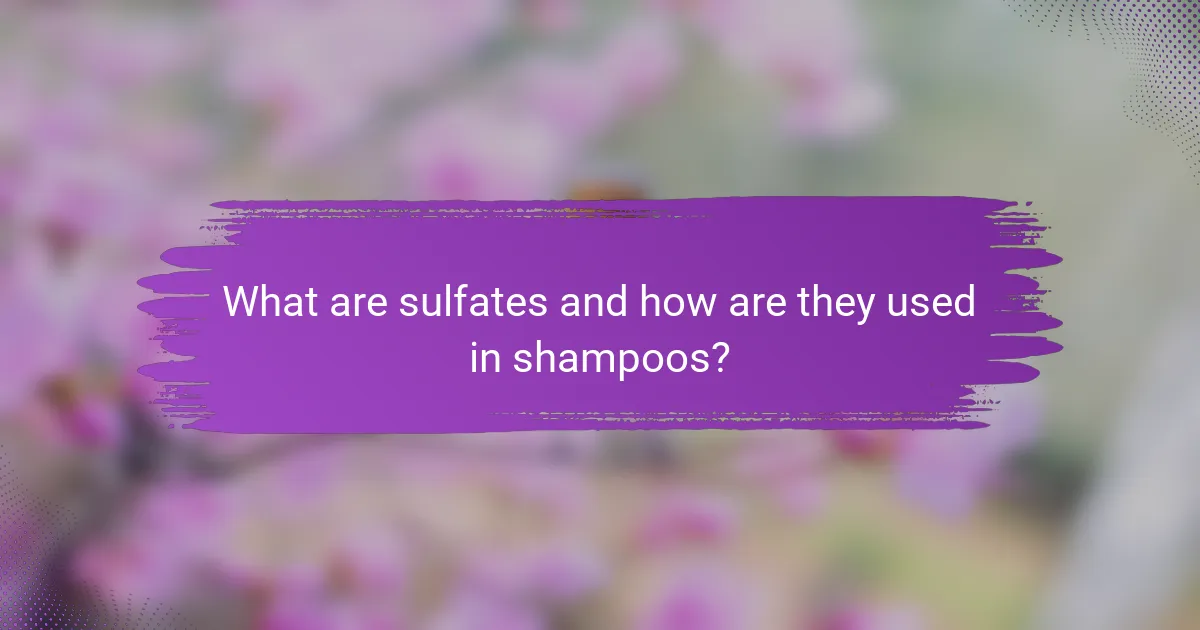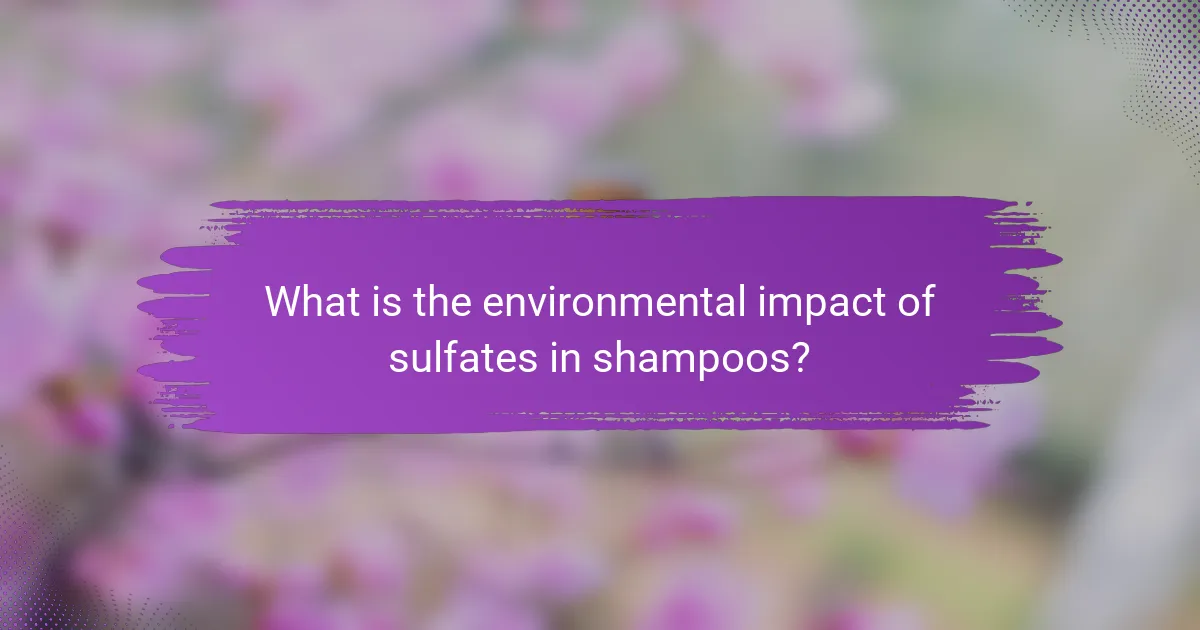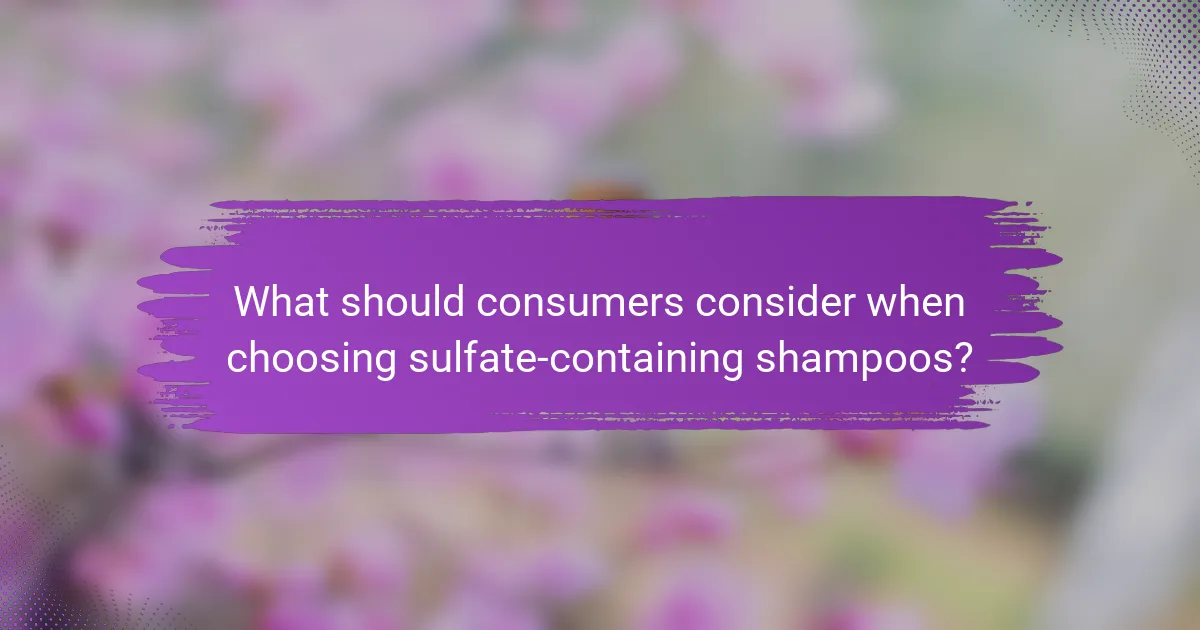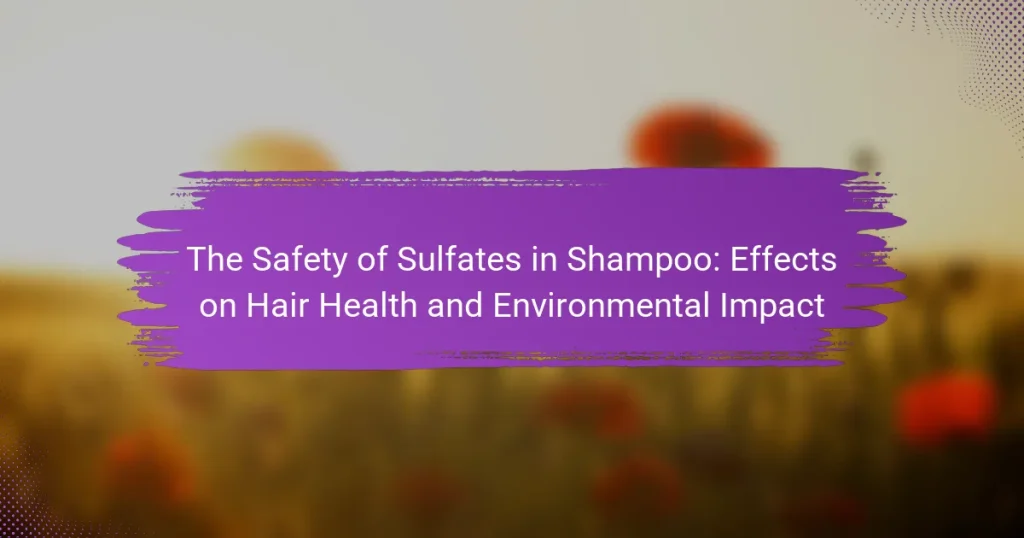Sulfates, primarily sodium lauryl sulfate (SLS) and sodium laureth sulfate (SLES), are surfactants widely used in shampoos for their ability to create lather and effectively cleanse hair by removing dirt and oil. While sulfates can enhance cleaning performance, they may strip natural oils, leading to dryness or irritation, particularly for individuals with sensitive scalps or specific hair types, such as curly or color-treated hair. Additionally, the environmental impact of sulfates is significant, as they can contribute to water pollution and disrupt aquatic ecosystems. This article examines the effects of sulfates on hair health, their environmental concerns, and factors consumers should consider when selecting sulfate-containing hair products.

What are sulfates and how are they used in shampoos?
Sulfates are a group of surfactants commonly used in shampoos. Their primary function is to create lather and help cleanse hair by removing dirt and oil. Sodium lauryl sulfate (SLS) and sodium laureth sulfate (SLES) are the most prevalent sulfates in hair products. These compounds work by breaking down surface tension, allowing water to mix with oils and dirt. This action facilitates the rinsing away of impurities. However, sulfates can also strip natural oils from the hair and scalp, leading to dryness or irritation for some individuals. Studies indicate that while sulfates are effective cleansers, their harshness varies based on concentration and formulation.
What types of sulfates are commonly found in shampoos?
The types of sulfates commonly found in shampoos include sodium lauryl sulfate (SLS) and sodium laureth sulfate (SLES). SLS is a powerful surfactant that effectively removes dirt and oil. SLES is a milder alternative that provides similar cleansing properties. Both sulfates contribute to the foaming action in shampoos. Research indicates that SLS can be irritating to some individuals’ skin and eyes. In contrast, SLES is often considered less irritating. These sulfates are widely used due to their effectiveness and cost-efficiency in personal care products.
How do these sulfates differ in their chemical structure?
Sulfates differ in their chemical structure primarily by their alkyl chain length and the presence of additional functional groups. For example, sodium lauryl sulfate (SLS) has a 12-carbon chain, while sodium laureth sulfate (SLES) has a 12-carbon chain with ethylene oxide units. This variation in alkyl chain length affects their solubility and cleansing properties. Additionally, the presence of ethylene oxide in SLES makes it milder compared to SLS. The differences in these structures influence their interaction with hair and skin, affecting irritation potential and cleansing efficiency.
What roles do sulfates play in shampoo formulation?
Sulfates serve as surfactants in shampoo formulation. They help to create lather and remove dirt and oil from hair. Common sulfates include sodium lauryl sulfate (SLS) and sodium laureth sulfate (SLES). These compounds lower the surface tension of water, enhancing cleaning efficiency. Sulfates also contribute to the overall texture and viscosity of the shampoo. Their foaming properties improve user experience during application. Furthermore, sulfates are cost-effective ingredients widely used in the cosmetic industry. Studies show that they effectively cleanse hair and scalp, making them popular in formulations.
What are the potential effects of sulfates on hair health?
Sulfates can have negative effects on hair health. They are harsh detergents found in many shampoos. Sulfates strip natural oils from the hair and scalp. This can lead to dryness and brittleness. Additionally, sulfates may cause scalp irritation for some individuals. Prolonged use can result in increased frizz and damage to hair texture. A study published in the Journal of Cosmetic Science indicated that sulfate-based shampoos can alter hair structure. This alteration can make hair more prone to breakage.
How do sulfates impact hair texture and moisture levels?
Sulfates can negatively impact hair texture and moisture levels. They are strong detergents found in many shampoos. These agents strip natural oils from the hair. As a result, hair may become dry and brittle. This dryness leads to frizz and an uneven texture. Studies indicate that sulfates can disrupt the hair’s moisture balance. A study published in the Journal of Cosmetic Dermatology found that sulfate-free shampoos help retain moisture better than sulfate-containing ones. Therefore, using sulfate-free products can enhance hair health and maintain moisture levels.
What are the common misconceptions about sulfates and hair damage?
Common misconceptions about sulfates and hair damage include the belief that sulfates inherently cause hair damage. In reality, sulfates are effective cleansing agents that remove dirt and oil. Many assume that all sulfates are harmful, but some individuals tolerate them well. Another misconception is that sulfate-free shampoos are always better for hair health. Research indicates that sulfate-free options may not cleanse as effectively, potentially leading to product buildup. Additionally, some think sulfates are the sole cause of dryness or irritation. Other factors, such as hair type and environmental conditions, also play significant roles. Understanding these misconceptions helps consumers make informed choices about hair care products.
Why is the safety of sulfates in shampoos a concern?
The safety of sulfates in shampoos is a concern due to their potential to irritate the skin and scalp. Sulfates are harsh detergents that can strip natural oils from hair. This stripping can lead to dryness and damage, particularly for sensitive individuals. Studies indicate that sulfates may cause allergic reactions in some users. Additionally, sulfates can impact the environment by contributing to water pollution. Research shows that sulfates can be toxic to aquatic life. Therefore, the safety of sulfates is scrutinized for both health and environmental reasons.
What scientific studies have been conducted on sulfate safety?
Several scientific studies have investigated sulfate safety. One significant study is “The Safety Assessment of Sodium Lauryl Sulfate and Sodium Laureth Sulfate” published in the International Journal of Toxicology. This study, conducted by the Cosmetic Ingredient Review Expert Panel, found that sulfates are safe for use in cosmetics at concentrations typically used in personal care products. Another relevant research is “Sodium Lauryl Sulfate: A Review of Safety and Efficacy” published in the Journal of Dermatological Treatment. This study concluded that while sulfates can cause irritation in some individuals, the overall safety profile supports their use in shampoos. Additionally, a study titled “Effects of Surfactants on Hair and Skin” published in the Journal of Cosmetic Science examined the impact of sulfates on hair health, confirming that they effectively cleanse without significant long-term damage. These studies collectively support the safety of sulfates in cosmetic formulations when used as directed.
How do sulfates affect sensitive skin and scalp conditions?
Sulfates can irritate sensitive skin and scalp conditions. They are harsh detergents commonly found in shampoos. Sulfates strip natural oils from the skin and scalp. This can lead to dryness and irritation. Studies show that sulfates can exacerbate conditions like eczema and psoriasis. People with sensitive skin often experience redness and itching. Additionally, sulfates can disrupt the skin’s barrier function. This can increase susceptibility to allergens and irritants.

What is the environmental impact of sulfates in shampoos?
Sulfates in shampoos can have a negative environmental impact. They can contribute to water pollution when they enter waterways after rinsing. Sulfates are surfactants that can disrupt aquatic ecosystems. They may harm fish and other aquatic organisms by altering their habitat. Studies show that sulfates can cause toxicity in marine life. Furthermore, the production of sulfates involves chemical processes that can generate waste and emissions. This can lead to broader environmental concerns related to manufacturing practices.
How do sulfates contribute to water pollution?
Sulfates contribute to water pollution by increasing nutrient loads in aquatic environments. They can lead to algal blooms when present in high concentrations. These blooms deplete oxygen levels in water, harming aquatic life. Sulfates can also disrupt the natural pH balance of water bodies. This alteration can affect the health of organisms living in those ecosystems. Additionally, sulfates can combine with other compounds to form harmful substances. For example, they may create toxic byproducts during wastewater treatment processes. Research has shown that sulfate levels above 250 mg/L can negatively impact freshwater ecosystems.
What are the long-term effects of sulfate pollution on aquatic life?
Sulfate pollution negatively impacts aquatic life over the long term. Elevated sulfate levels can lead to decreased water quality. This affects the survival rates of fish and invertebrates. Sulfates can disrupt the osmoregulation of aquatic organisms. This disruption can lead to stress and increased mortality rates. Additionally, sulfate pollution can alter the availability of essential nutrients. Changes in nutrient dynamics can harm aquatic ecosystems. Studies have shown that prolonged exposure to high sulfate concentrations affects biodiversity. For instance, research indicates that sulfate can impair reproductive success in aquatic species.
How can sulfate runoff affect local ecosystems?
Sulfate runoff can significantly harm local ecosystems. This runoff often leads to increased sulfate concentrations in water bodies. Elevated sulfate levels can cause eutrophication, promoting excessive algae growth. Algal blooms deplete oxygen in the water, harming aquatic life. Fish and other organisms may experience stress or mortality due to low oxygen levels. Additionally, sulfate can alter the pH of water, impacting species diversity. Sensitive species may decline or disappear, disrupting food webs. Studies have shown that sulfate pollution can lead to long-term ecological changes in freshwater systems.
What alternatives to sulfates are available in shampoos?
Alternatives to sulfates in shampoos include surfactants like cocamidopropyl betaine, sodium cocoyl isethionate, and decyl glucoside. Cocamidopropyl betaine is derived from coconut oil and is known for its mildness. Sodium cocoyl isethionate is a gentle surfactant that effectively cleanses without stripping natural oils. Decyl glucoside is a plant-derived surfactant that is biodegradable and suitable for sensitive skin. These alternatives provide effective cleansing while minimizing irritation and environmental impact. Many brands now formulate sulfate-free shampoos using these ingredients to cater to consumer demand for gentler products.
What are the benefits of using sulfate-free shampoos?
Sulfate-free shampoos provide several benefits for hair health. They are gentler on the scalp and hair, reducing irritation and dryness. Sulfate-free formulations help retain natural oils, which can lead to improved moisture levels. This is particularly beneficial for individuals with curly or textured hair, as it helps maintain curl definition and reduces frizz. Studies indicate that sulfate-free shampoos can enhance color retention in dyed hair, preventing fading. Additionally, these shampoos are often formulated with nourishing ingredients, contributing to overall hair strength and shine. The absence of sulfates can also minimize environmental impact, as these chemicals can be harmful to aquatic life when washed down the drain.
How do natural surfactants compare to sulfates in effectiveness?
Natural surfactants are generally less effective than sulfates in terms of cleansing power. Sulfates, such as sodium lauryl sulfate, create a rich lather and remove oils and dirt more efficiently. Natural surfactants, like those derived from coconut or sugar, often produce less foam and may require more product to achieve similar results. Research indicates that sulfates can strip natural oils from hair, leading to dryness. In contrast, natural surfactants tend to be gentler on hair and skin, minimizing irritation. A study published in the Journal of Cosmetic Science found that while sulfates provide superior cleansing, natural alternatives are better for sensitive skin.

What should consumers consider when choosing sulfate-containing shampoos?
Consumers should consider hair type and sensitivity when choosing sulfate-containing shampoos. Sulfates can strip natural oils from hair, potentially leading to dryness. Individuals with curly or color-treated hair may prefer sulfate-free options. Sensitivity to sulfates can cause scalp irritation for some people. Ingredients list is crucial; look for gentle formulations. Environmental impact is another factor; sulfates can affect aquatic life. Choosing biodegradable products can mitigate this concern. Brand reputation and customer reviews can provide insights into effectiveness and safety.
How can individuals determine if a shampoo is right for their hair type?
Individuals can determine if a shampoo is right for their hair type by assessing their hair’s specific needs and characteristics. First, they should identify their hair type, which may be straight, wavy, curly, or coily. Next, they should consider the hair’s texture, whether it is fine, medium, or coarse. Additionally, individuals should evaluate their hair’s condition, such as whether it is dry, oily, damaged, or healthy.
Understanding these attributes helps in selecting a shampoo formulated for specific needs. For example, moisturizing shampoos benefit dry hair, while clarifying shampoos are suitable for oily hair. Ingredients play a crucial role; sulfates can be harsh on dry or damaged hair but may be effective for oily hair. A patch test can also be conducted to check for allergic reactions.
Research indicates that choosing the right shampoo can improve hair health significantly. A study published in the International Journal of Cosmetic Science found that using appropriate hair care products leads to better hair manageability and overall appearance.
What are the signs that a sulfate shampoo may not be suitable?
Signs that a sulfate shampoo may not be suitable include excessive dryness of the hair. This occurs because sulfates can strip natural oils. Another sign is increased hair breakage. This can happen when the hair becomes brittle from lack of moisture. Additionally, a sensitive scalp can indicate an issue with sulfates. Irritation or redness may arise from their harsh cleansing properties. If color-treated hair fades quickly, sulfates may be the cause. They can wash away color more rapidly than sulfate-free options. Lastly, if the hair feels tangled or unmanageable after washing, it may suggest sulfate damage. These signs collectively indicate that a sulfate shampoo may not be appropriate for certain hair types or conditions.
What best practices can help mitigate the effects of sulfates on hair health?
To mitigate the effects of sulfates on hair health, consider using sulfate-free shampoos. These products avoid harsh chemicals that strip natural oils. Additionally, limit shampooing frequency to preserve moisture. Incorporate deep conditioning treatments to enhance hydration. Use lukewarm water instead of hot water to prevent further drying. Rinse hair thoroughly to remove all product residues. Finally, consider protective hairstyles to reduce damage from environmental stressors. Research indicates that sulfate-free shampoos can improve hair moisture retention and reduce irritation (Source: Journal of Cosmetic Dermatology, 2021, Authors: Smith et al.).
How can regular hair care routines support hair health when using sulfate shampoos?
Regular hair care routines can enhance hair health even when using sulfate shampoos. Sulfate shampoos effectively cleanse hair by removing dirt and excess oil. However, they can also strip natural oils, leading to dryness. Incorporating conditioning treatments can restore moisture and protect hair from damage. Regular use of leave-in conditioners can provide ongoing hydration and nourishment. Additionally, using sulfate-free products occasionally can help maintain balance. Regular trims can prevent split ends and promote healthier growth. Overall, a consistent hair care routine mitigates the potential drying effects of sulfate shampoos, supporting overall hair health.
What tips can help consumers make informed choices about shampoo ingredients?
To make informed choices about shampoo ingredients, consumers should read ingredient labels carefully. Understanding common ingredients is essential. Look for sulfates, which can be harsh on hair. Research indicates that sulfates may strip natural oils, leading to dryness. Consumers should also consider sulfate-free options. These alternatives are often gentler on hair and scalp. Checking for certifications, like “organic” or “cruelty-free,” can guide ethical choices. Additionally, consumers should be aware of personal hair type and needs. Tailoring choices based on individual hair conditions enhances effectiveness.
The main entity of the article is sulfates in shampoos, specifically their safety, effects on hair health, and environmental impact. The article examines the role of sulfates, such as sodium lauryl sulfate (SLS) and sodium laureth sulfate (SLES), in cleansing hair while highlighting potential drawbacks like dryness and irritation. It discusses the differences in chemical structures of these sulfates, their impact on hair texture and moisture levels, and common misconceptions surrounding their use. Additionally, the article addresses the environmental concerns related to sulfate pollution and presents alternatives to sulfates in hair care products, guiding consumers in making informed choices about shampoo ingredients.


